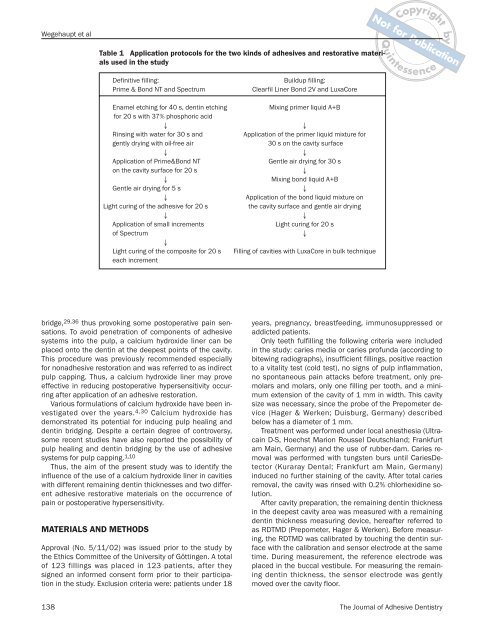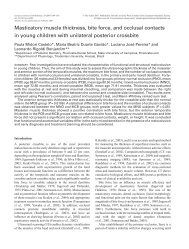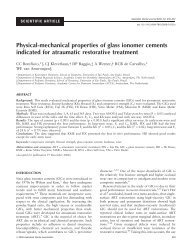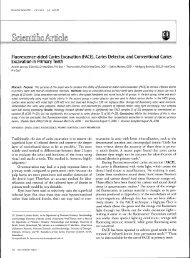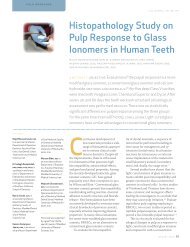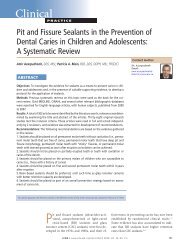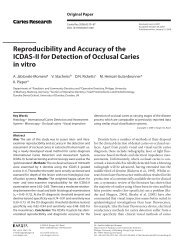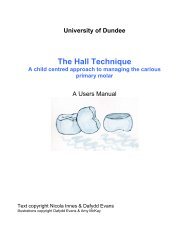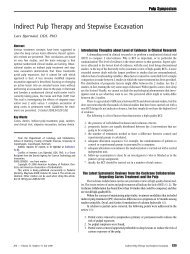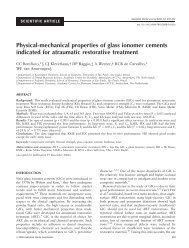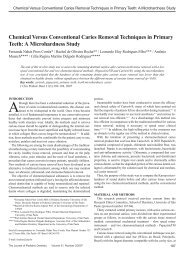Quintessence Journals - Sandra Kalil Bussadori
Quintessence Journals - Sandra Kalil Bussadori
Quintessence Journals - Sandra Kalil Bussadori
You also want an ePaper? Increase the reach of your titles
YUMPU automatically turns print PDFs into web optimized ePapers that Google loves.
Wegehaupt et al<br />
Table 1 Application protocols for the two kinds of adhesives and restorative materials<br />
used in the study<br />
Definitive filling:<br />
Prime & Bond NT and Spectrum<br />
Buildup filling:<br />
Clearfil Liner Bond 2V and LuxaCore<br />
Not for Publication<br />
Copyright<br />
<strong>Quintessence</strong><br />
for<br />
Not<br />
by<br />
Enamel etching for 40 s, dentin etching<br />
for 20 s with 37% phosphoric acid<br />
↓<br />
Rinsing with water for 30 s and<br />
gently drying with oil-free air<br />
↓<br />
Application of Prime&Bond NT<br />
on the cavity surface for 20 s<br />
↓<br />
Gentle air drying for 5 s<br />
↓<br />
Light curing of the adhesive for 20 s<br />
↓<br />
Application of small increments<br />
of Spectrum<br />
↓<br />
Light curing of the composite for 20 s<br />
each increment<br />
Mixing primer liquid A+B<br />
↓<br />
Application of the primer liquid mixture for<br />
30 s on the cavity surface<br />
↓<br />
Gentle air drying for 30 s<br />
↓<br />
Mixing bond liquid A+B<br />
↓<br />
Application of the bond liquid mixture on<br />
the cavity surface and gentle air drying<br />
↓<br />
Light curing for 20 s<br />
↓<br />
Filling of cavities with LuxaCore in bulk technique<br />
bridge, 29,36 thus provoking some postoperative pain sensations.<br />
To avoid penetration of components of adhesive<br />
systems into the pulp, a calcium hydroxide liner can be<br />
placed onto the dentin at the deepest points of the cavity.<br />
This procedure was previously recommended especially<br />
for nonadhesive restoration and was referred to as indirect<br />
pulp capping. Thus, a calcium hydroxide liner may prove<br />
effective in reducing postoperative hypersensitivity occurring<br />
after application of an adhesive restoration.<br />
Various formulations of calcium hydroxide have been investigated<br />
over the years. 4,30 Calcium hydroxide has<br />
demonstrated its potential for inducing pulp healing and<br />
dentin bridging. Despite a certain degree of controversy,<br />
some recent studies have also reported the possibility of<br />
pulp healing and dentin bridging by the use of adhesive<br />
systems for pulp capping. 1,10<br />
Thus, the aim of the present study was to identify the<br />
influence of the use of a calcium hydroxide liner in cavities<br />
with different remaining dentin thicknesses and two different<br />
adhesive restorative materials on the occurrence of<br />
pain or postoperative hypersensitivity.<br />
MATERIALS AND METHODS<br />
Approval (No. 5/11/02) was issued prior to the study by<br />
the Ethics Committee of the University of Göttingen. A total<br />
of 123 fillings was placed in 123 patients, after they<br />
signed an informed consent form prior to their participation<br />
in the study. Exclusion criteria were: patients under 18<br />
years, pregnancy, breastfeeding, immunosuppressed or<br />
addicted patients.<br />
Only teeth fulfilling the following criteria were included<br />
in the study: caries media or caries profunda (according to<br />
bitewing radiographs), insufficient fillings, positive reaction<br />
to a vitality test (cold test), no signs of pulp inflammation,<br />
no spontaneous pain attacks before treatment, only premolars<br />
and molars, only one filling per tooth, and a minimum<br />
extension of the cavity of 1 mm in width. This cavity<br />
size was necessary, since the probe of the Prepometer device<br />
(Hager & Werken; Duisburg, Germany) described<br />
below has a diameter of 1 mm.<br />
Treatment was performed under local anesthesia (Ultracain<br />
D-S, Hoechst Marion Roussel Deutschland; Frankfurt<br />
am Main, Germany) and the use of rubber-dam. Caries removal<br />
was performed with tungsten burs until CariesDetector<br />
(Kuraray Dental; Frankfurt am Main, Germany)<br />
induced no further staining of the cavity. After total caries<br />
removal, the cavity was rinsed with 0.2% chlorhexidine solution.<br />
After cavity preparation, the remaining dentin thickness<br />
in the deepest cavity area was measured with a remaining<br />
dentin thickness measuring device, hereafter referred to<br />
as RDTMD (Prepometer, Hager & Werken). Before measuring,<br />
the RDTMD was calibrated by touching the dentin surface<br />
with the calibration and sensor electrode at the same<br />
time. During measurement, the reference electrode was<br />
placed in the buccal vestibule. For measuring the remaining<br />
dentin thickness, the sensor electrode was gently<br />
moved over the cavity floor.<br />
138 The Journal of Adhesive Dentistry


